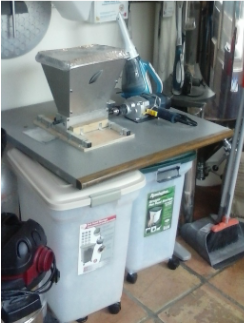Who Are We?
|
|
The Brewery and How We Brew Beer
Brewing beer starts with ordering ingredients. We strive to obtain quality ingredients from the Pacific Northwest which is easy given that Washington State is one of the top growers of hops in the world. The majority of our malts come from Great Western which sources grains from Washington, Oregon and Idaho. For some of our European Ales, we sometimes get hops from the country where the beer style originates. This allows us to achieve authentic taste profiles. At current production we go through about 1000 lbs of grains (mostly barley, but some wheat, rye and oats) and 20 lbs of hops every few weeks. This is slated to increase as our production capacity is growing by more than 60% in the next few weeks. We get a pallet with all the good stuff dumped onto our taproom floor every few weeks and then it's hustling to move the bags into our storage areas before we open the taproom for business! (For some reason, the truck always delivers just a couple of hours before we open and never on a day that we're closed....) |
|
Our main storage area is this cool, red steel rack. This rack is rated for 4000 lbs. and can hold almost an entire shipment. Here we store all of the base malts and some malts that we use frequently (e.g. wheat malt, munich malt). Most of the specialty malts are stored in an upstairs loft area in grain bins. All in all we have about 20 different types of malt that we use regularly. |
|
The grains are then wheeled to the brewhouse and added to the mash tun (far right kettle). Here the grains are steeped with hot water to convert the starches into sugars (called "mashing"). Sometimes the rotating action of the re-circulating liquid creates beautiful patterns, akin to cappuccino foam art... |
|
After sparging, boiling, adding hops and a few other steps and additions, the wort is chilled and transferred to a fermenter. We currently have four fermenters, three 55-gal and one 125-gal. After aeration, the yeast is added and the beer ferments for 2-3 weeks, converting the sugar into alcohol and carbon dioxide. To be continued... |







